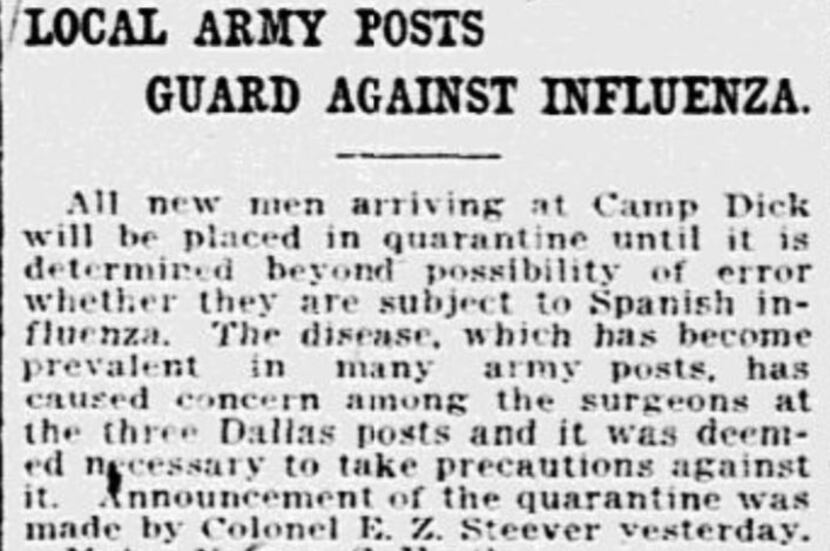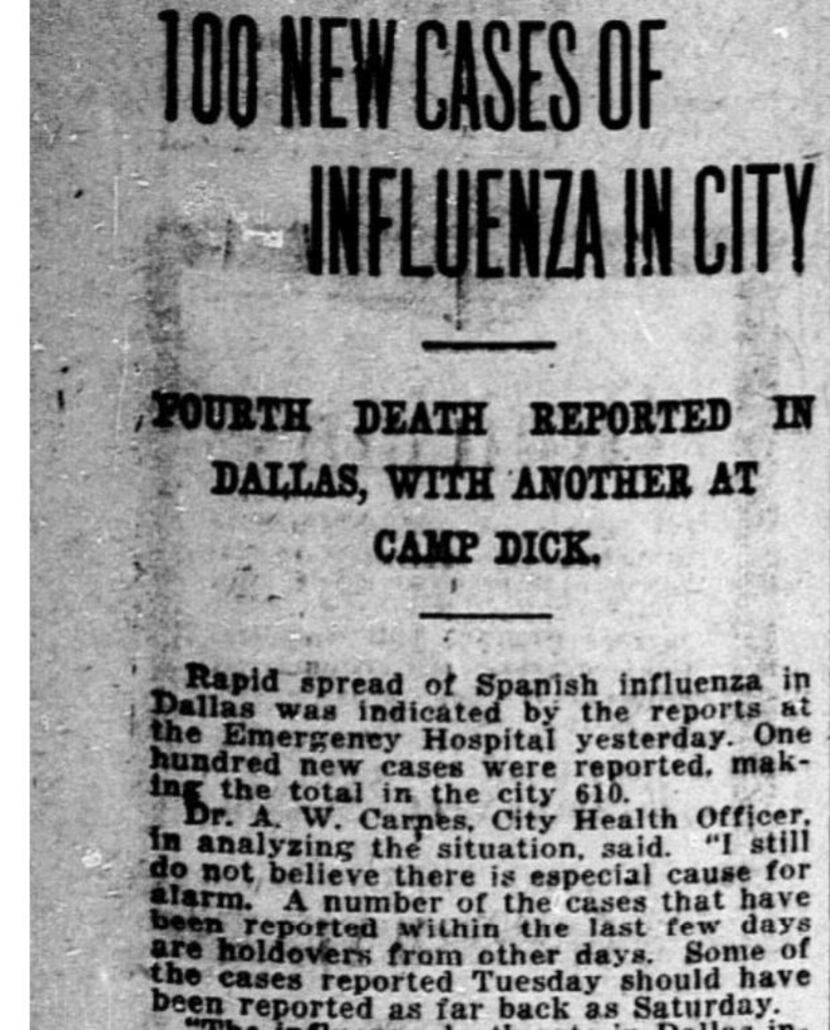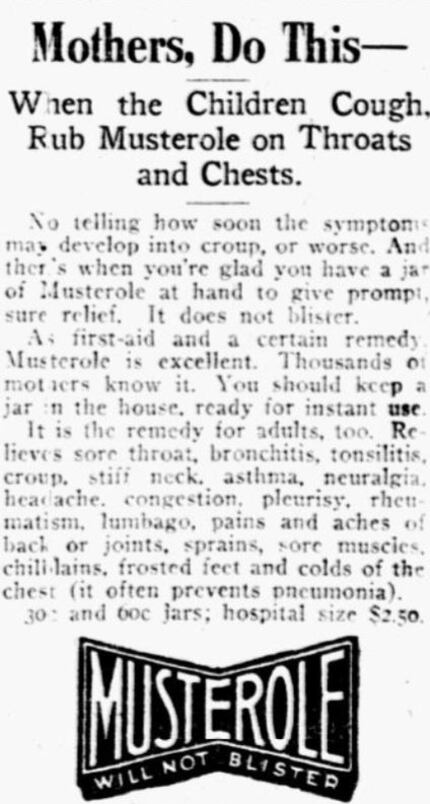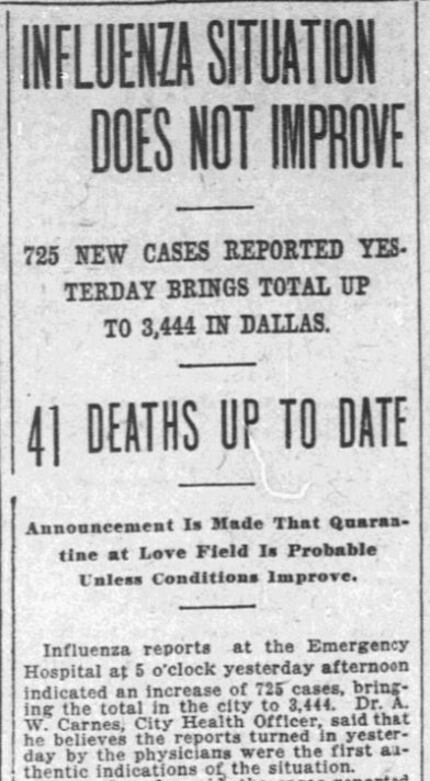Editor’s note: Take a look back in The Dallas Morning News Archives.
The year was 1918 and Army camps in Texas swelled with young men training to fight in Europe in World War I.
But an invisible enemy already posed a deadly threat: The Spanish flu of 1918 killed thousands of soldiers across the country before they ever made it to the battlefield. It swept through cities and towns, spreading fear. The flu ultimately claimed more than 50 million lives worldwide — including more than 500,000 Americans — and infected hundreds of millions of others.
One hundred years later, as Dallas faces another deadly flu outbreak, the Spanish flu has been largely forgotten by the public.
But not by those who study viral infection and the way it spreads.
“It is probably the greatest killer of all time. It killed more people in the world than any other known epidemic in history,” said Dr. Robert Haley, director of UT Southwestern's Epidemiology Division.
The flu virus is constantly changing and mutating into new strains. This year's flu virus is different from the last -- as well as the one that struck 100 years ago - and so the vaccinations change each year as well.
Nevertheless, a pandemic like the 1918 Spanish flu will happen again, Haley said. It’s not a matter of if but when. If the right strain of a human flu virus mixes with the flu virus of a pig and a bird, it can create a new and far more lethal strain to which humans have little preexisting immunity.
“Then our goose is cooked,” Haley said.
“It’s going to happen, but we just don’t know when,” Haley said. “It's a numbers game.”

Flu spreads to North Texas
In September 1918, about 150,000 people lived in Dallas — around 10 percent of the current population.
The front pages of local newspapers that month were dominated by news of the war raging in Europe. Closer to home, young men surged into army training camps around Texas and Dallas, including Camp Dick on the grounds of Fair Park. The State Fair of Texas had been canceled so the land could be converted temporarily into an Army training camp.
The Dallas Morning News carried reports of the flu in other parts of the country, including Army posts around the country. The outbreak likely started in Kansas at Fort Riley, where the first cases were recorded, Haley said. The doctor serving the post alerted public health authorities, but his report was ignored.
That spring, a mild version of the flu had showed up without doing much harm. But it returned in much more virulent form in late summer. Previous versions of the flu typically affected the sick, the very young and the very old. This version attacked healthy young adults the hardest, with the highest mortality rate among those ages 20 to 40, according to the Centers for Disease Control and Prevention.
“That’s why it affected young soldiers,” Haley said.

The virus triggered a “cytokine storm,” causing a massive overproduction of the cells used to fight off infections, which resulted in organ failure, he said. In many victims, this reaction to the virus destroyed the lungs.
“They were dead in less than a day. They’d fall ill in the morning, be coughing up blood by the afternoon and dead that evening,” Haley said. “They drowned in their own blood or from a lack of oxygen.”
The flu also could lead to pneumonia, for which there were no antibiotics.

The flu spread quickly across the U.S., following railroad lines, said Dr. Peggy Redshaw, and expert on the Spanish flu and a professor emeritus of biology. “It ripped through the railroad community,” Redshaw said.
By the time it hit Sherman in September, panic had set in. “People were thinking this was the end of the world,” said Redshaw, who has produced a study on the flu’s impact on Sherman.
That month in Dallas, Camp Dick began to quarantine new men arriving at the post to ensure they weren’t infected.
Still, Dallas city health officials didn't seem overly worried. On Sept. 29, The News carried a report headlined "Influenza Scare is Rapidly Subsiding," which cited "sporadic cases of Spanish influenza" that had been reported to the City Emergency Hospital. Dr. A.W. Carnes, the city's health officer, said the local cases resembled the old-fashioned grip, or cold, and did not approach the proportions of an epidemic.
The News ended its story on a positive note: "In the opinion of the military and civil doctors, the Spanish influenza scare is unwarranted by local conditions. The few cases of grip, it is claimed, are to be expected as the result of the recent rainy weather."
But in Fort Worth, where Camp Bowie had already reported 40 cases of the flu, Army leaders imposed a ban on soldiers coming together for dances or for watching movies, playing pool, and the like.
Despite the risk, on Sept. 28 Dallas went ahead with one special gathering.
Parade draws thousands
Thousands of residents flocked downtown to see 5,000 civilians and 2,500 soldiers march in a parade as part of the Fourth Liberty Loan campaign to sell bonds to fund the war effort. As the band played “For Your Boy and My Boy” and other patriotic songs, huge crowds spilled across Main and Elm streets. “By tens of thousands the citizenship watched and cheered and applauded. ... It simply was Dallas showing what she intends to do when the loan drive opens tomorrow.”
After the parade, flu cases increased exponentially, according to a report in The News on Oct. 4, 1918. A total of 76 cases were reported on Oct. 3, twice as many as were reported the previous two days. The News also reported the city's first flu death that day. Pierpont Balderson, 15, died at St. Paul's Hospital. After being stricken with the flu, he came down with pneumonia.

Carnes hesitated to impose a quarantine, though other city leaders urged him to do so and nearby military camps were already isolating the sick. On Oct. 12, Mayor Joseph E. Lawther decided to take the matter into his own hands, ordering a temporary halt of all public gatherings, including the closing of public and private schools, colleges and universities, and churches.
That day, another 725 cases were reported to the City Emergency Hospital, bringing the city’s overall total to 3,444. That was almost 20 times more than the 185 total cases reported just nine days earlier on Oct. 3.
Fort Worth's Camp Bowie had 40 cases of the flu, The News reported on Sept. 27. By Oct. 6, that number had jumped to "nearly 2,000" cases and four deaths.
Many cases of the flu were never officially recorded. “The record keeping was terrible,” Redshaw said.
Flu hit entire families
The flu did not discriminate, hitting the well-off and the poor, including entire families. A story on Oct. 26 quoted a nurse saying that a family of nine people of Mexican heritage had all been stricken by the flu, including three in the last stages of pneumonia. When a landlord threatened to evict a sick family, United Charities stepped in to pay the rent. The group also provided groceries and medication for others who were too sick to work.
Doctors and nurses also came down with the flu, impairing the city’s ability to care for the sick.

October proved to be the worst month. But the epidemic continued to unfold into December before finally winding down in the spring of 1919. It is difficult to determine the full impact of the flu epidemic. The Dallas Evening Journal estimated the city was hit with more than 9,000 cases of the flu and 350 deaths from infection. On Dec. 13, The News reported that 456 residents had died from the flu or pneumonia since Oct. 1.
For all of Texas, the number of deaths in October increased 257 percent over September. Nearly 7 of every 10 deaths reported to the state were caused by influenza and related illnesses, including pneumonia.
Fort Worth medical authorities reported three deaths to every birth in October alone.

The end of World War I was announced on Nov. 11, 1918. But the flu continued into the spring of 1919 before finally burning out.
In the end, Haley and other experts believe that Spanish influenza likely shortened World War I — as the epidemic swept through the ranks of friend and foe alike.
Closer to home, with the war over and the flu subsiding, all soldiers at Camp Dick at Fair Park were given passes for Christmas. And within a year, the State Fair of Texas was back up and running.
It was called the Victory Fair.
Interested in exploring the history of public health crises in Dallas? Become a Dallas Morning News Plus subscriber at archives.dallasnews.com.

